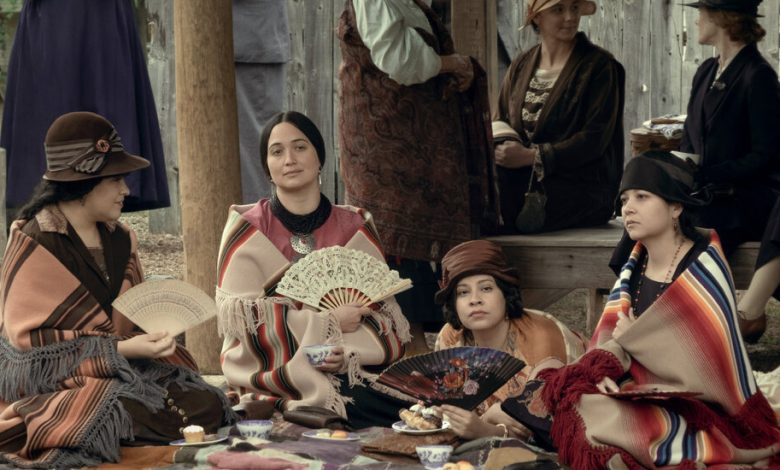What to Know About ‘Killers of the Flower Moon’: A Guide to the Osage Murders

In the 1920s, at least 60 Osage people were murdered or went missing in Oklahoma. Their white killers often married the victims before dispatching them. With shares of the tribe’s immense oil profits at stake, the scheme made them rich.
Until one of them shot Anna Brown in the back of the head in May 1921 and dumped her body in a ravine, a killing so brutal that a recently formed organization of undercover officers, the precursor to the F.B.I., took notice. The agency conducted a sprawling investigation that culminated in the arrests of three of Brown’s relatives, including her brother-in-law, Ernest Burkhart, bringing an end to what the Osage called the Reign of Terror.
These events are the subject of Martin Scorsese’s new three-and-a-half-hour epic, “Killers of the Flower Moon,” which arrives in theaters on Friday. Based on David Grann’s nonfiction book of the same name, it stars Leonardo DiCaprio as Burkhart; Lily Gladstone as Mollie Kyle, the wealthy Osage woman he marries; and Robert De Niro as Burkhart’s scheming uncle, William King Hale, who is responsible for the whole operation.
Unlike Grann’s book, which also chronicles the birth of the F.B.I., Scorsese’s film focuses on the effects of the murders in the Osage community. Here is what you need to know about the real people and events dramatized in the film.
Who are the Osage?
The Osage once lived across much of the central United States. In the early 1870s, the U.S. government forced them to leave their land in Kansas and move to a rocky, presumably worthless reservation in northeastern Oklahoma.
But the Osage were one of the few American Indian nations to buy their own reservation — using the proceeds from the sale of their Kansas lands to white settlers — meaning they retained sovereignty and more rights to their Oklahoma property.
How did they become so wealthy?
Their new reservation turned out to be ill-suited for farming but rich in oil.
After large deposits were discovered in 1894, the Osage, who retained communal mineral rights, came into enormous wealth: Prospectors had to pay the tribe for leases to extract the oil, as well as royalties on the profits. In 1923 alone, the Osage earned $30 million in royalties, the equivalent of roughly $540 million today.
By the 1920s, many of the Osage lived in mansions and had chauffeured cars. There was even a Tiffany’s counter at the local trading post.
Who was William King Hale?
Hale, the self-proclaimed “King of the Osage Hills,” was a well-connected and politically influential white cattle rancher who appeared to be a staunch ally of the Osage, from whom he bought and leased thousands of acres. He befriended and traded with them, building up power and prestige through gifts and favors. Privately, though, he resented their enormous wealth and began plotting with other white men to get their hands on it.
Why did Hale and his confederates want to kill the Osage?
Every one of the 2,229 members on the Osage tribal rolls in 1907 was entitled to an equal share of the oil royalties, a dispensation known as a headright. These payments could amount to as much as $13,000 per year per person, or the equivalent of $232,000 today. A family of four would have received the equivalent of about $928,000 a year.
In 1921, the U.S. government passed a law — purportedly to help the Osage manage their wealth — that deemed a vast majority “incompetent” to handle more than a limited sum of money and required their payments to be funneled through court-appointed guardians. These people, who were white lawyers and businessmen, more often than not shortchanged their wards.
So why not simply buy or extort a headright rather than kill? There was a legal wrinkle: Headrights could not be bought or sold, only inherited. Non-Osage men would marry into families with headrights and then sometimes murder entire families, including their own wives, to ensure they would end up in possession of one or more shares.
Who was Mollie Burkhart?
Mollie Kyle was a single woman from a wealthy Osage family, which made her a target. In 1917, Ernest Burkhart, the handsome 20-something nephew of William Hale, married her at the urging of his uncle, who had designs on her and her family’s headrights.
A few years after they were married, members of Mollie’s family began dying in suspicious ways. First, in 1918, a sister, Minnie Smith, died of what doctors called a “peculiar wasting illness” (probably poisoning). Then, in 1921, another sister, Anna Brown, was shot in the back of the head and dumped in a ravine, a brutal contract killing orchestrated by Hale that kicked off the Reign of Terror. Over the next two years, Mollie’s mother, Lizzie Q, and her final surviving sister, Rita Smith, also died in a probable poisoning and a home explosion, respectively. With each death, Mollie — and therefore Ernest — inherited additional headrights.
There was another reason Mollie Burkhart was a perfect candidate for Hale’s scheme: She was diabetic, so a premature death would be easy to attribute to her illness at a time when insulin was not widely available. Corrupt doctors in Hale’s control began injecting her with poison under the guise of administering an experimental new treatment. (She recovered after moving away and getting treatment at a hospital.)
Why did it take so long for the federal government to intervene?
The Osage Tribal Council suspected Hale early on, but it couldn’t get anyone to testify against him: Hale had bribed or threatened many witnesses into silence. Local authorities declined to investigate or, in the case of the coroner, falsified documents. Hale also covered his tracks, participating in the murder investigations and even offering rewards for leads.
But in 1923, after the death toll had risen to more than two dozen, the council issued a resolution asking the federal government to look into the matter. That April, J. Edgar Hoover assigned agents from the Bureau of Investigation to the case. (It would later be renamed the Federal Bureau of Investigation.)
Posing as a cattle buyer, an insurance salesman, a medicine man and an oil prospector — a subplot that didn’t make it into the film — four undercover agents from the bureau, led by Tom White (played by Jesse Plemons), lived among the Osage for two years and gained their trust. Eventually, people began speaking out against Hale.
Did Hale ever confess?
After he and Ernest Burkhart were arrested in 1926 for the murders of Mollie’s sister Rita and her husband, Bill, the killings stopped. Hale, who by then had become a millionaire through a combination of insurance fraud and unfair trade with the Osage people, maintained his innocence, but Burkhart confessed and described his uncle’s role in the scheme. Burkhart also disclosed that at Hale’s request, he had personally hired the man responsible for murdering one of the Osage victims. (Read a 1926 New York Times report on the case here.)
In 1929, Hale was sentenced to life in prison for the murder of Henry Roan, Mollie’s cousin. Hale spent the next 18 years in prison before being paroled in 1947, when he went to work as a cowboy in Montana. He retired to Arizona and died in 1962. He never apologized or admitted to his actions. Burkhart was sentenced to life in prison in state court, paroled in 1937 and had it revoked in 1941 after robbing his former sister-in-law, Lillie Morrell Burkhart. He was paroled again in 1959 and pardoned in 1966.
Do the Osage still receive headright payments today?
Yes, and they can still be lucrative, though not as lucrative as during the oil boom in the 1920s. Part of their value comes from their relative scarcity: Though the tribe has roughly doubled in size since 1907, the number of headrights is still fixed at 2,229, meaning a recipient must have inherited or been willed an original share. Today, a headright can be worth thousands of dollars per year.
Around 25 percent of payments go to nontribal members, including non-Indians, churches, community organizations and even, in one case, a defunct care home, as Bloomberg reported.
What does the film’s title mean?
During May in the Oklahoma hills, blooming flowers die when taller plants crowd them out, so the Osage refer to that month as “the time of the flower-killing moon.” The murder of Anna Brown took place in May 1921, so the title also serves as a metaphor for what happened to the Osage.



